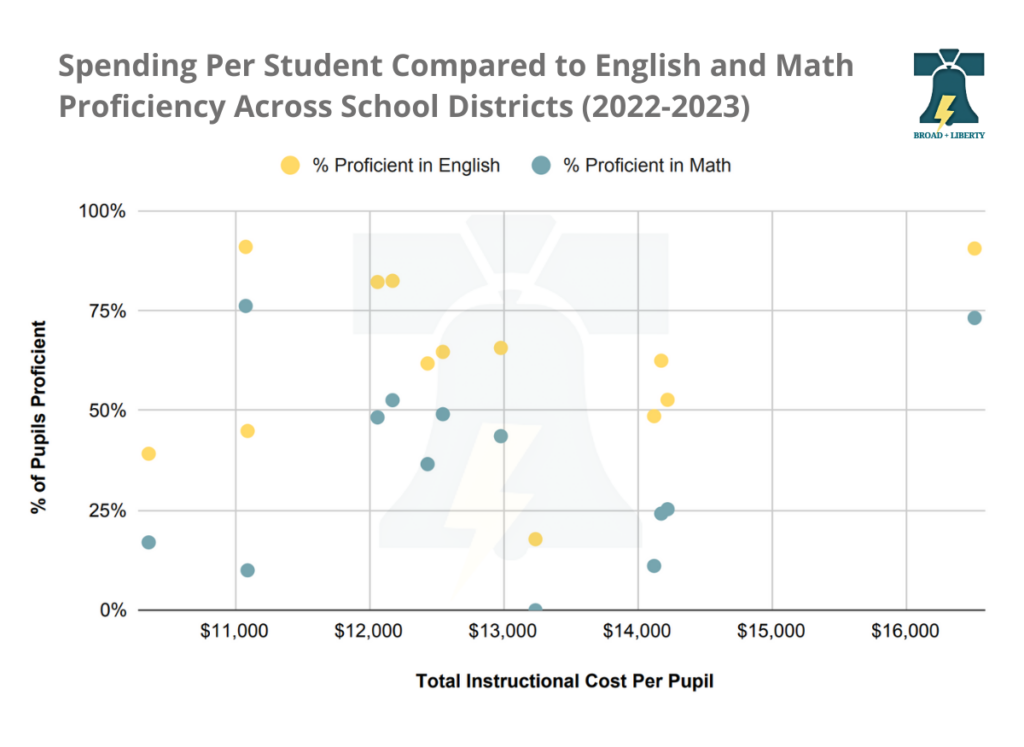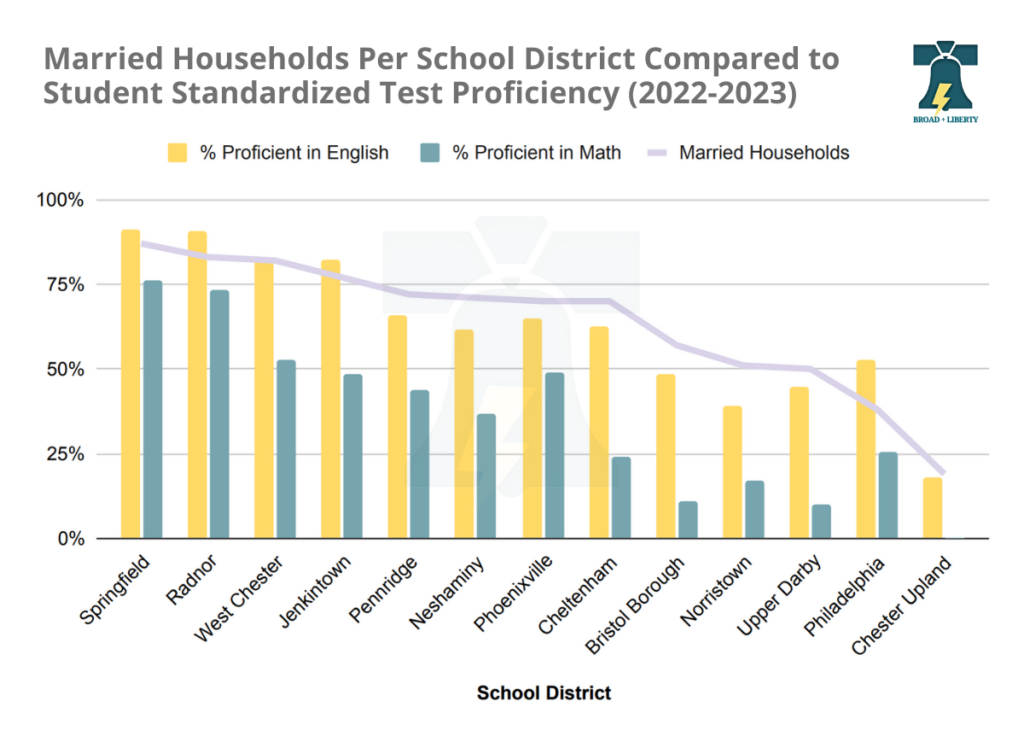by Wallace Nunn
Families matter as much as — or even more than — school funding from the state.

Two recent Broad + Liberty articles detailed issues in the Upper Darby School District at both the middle schools and the high school. Only 30.2 percent of Upper Darby high school students are proficient in Literature and only 7.3 percent in Algebra.
I am a member of Upper Darby High School’s Class of 1961. I served on the Upper Darby School Board in the 1980’s and 1990’s. My wife subsequently served on the board as well. I have a deep personal connection to the district and community. Such results are staggering and they make my heart heavy. And, they raise the basic question: why are they so bad?
Does the fault simply lie with the curriculum, the administration, the unions, or some combination thereof? After decades of significant spending increases, is the answer really more money, or are there other factors at work that are beyond the teachers’ and administrators’ control? Does the solution lie elsewhere, at least partially?
Politicians, the public, parents, and academicians have all weighed in on the crisis facing not only Upper Darby’s public schools, but our nation’s public schools. Many, if not all, of the solutions that have been put forward may have some validity, but we believe that it’s time to look beyond the schools and back to the communities that they serve.
Our research has led us to question the mantra that “more money is the answer.”
We have identified middle-class school districts that spend less than Upper Darby or Philadelphia and have outcomes that rival or surpass those of the wealthiest districts. Our research brings into question the notion that the difference between good, or even exceptional, student performance and poor outcomes is the amount of money spent on each student.
For example, Springfield School District (Delaware County) spends less per student than Philadelphia or Upper Darby and has student outcomes, as measured by state exams, that exceed or equal the county’s most affluent district, Radnor. They do this despite spending $10,000 dollars less per student. As you can see from the chart below the relationship between amount spent per student and student outcomes is tenuous at best.

How can this be? The answer may, at least partially, lie outside the school. We began looking for answers in the larger community and found that there seems to be a direct relationship between family structure and student success. Money spent on our schools can’t overcome one of the most essential factors of school success. Family is the most critical input in the potential of success in life and outcomes in school. It is impossible to adequately evaluate a school district’s performance without evaluating the community they serve. Perhaps this explains why charter schools can often succeed in a neighborhood where regular public schools fail. They require a certain level of parental involvement.
We are not suggesting that the public education bureaucracy does not need to do a better job: plainly stated, it does. However, to make meaningful, sustainable improvements, they need assistance. We believe that school districts cannot do this alone, as they are a function of the community that they serve, they need the community to provide an environment conducive to the development of successful children.
Family matters
As a part of our analysis, we compared outcomes from several local school districts and found that the results underscore the notion that the education of our children is not only dependent on our schools but also on our culture. This hypothesis is explained in greater detail in a book written last year by economist Melissa S. Kearney. In The Two-Parent Privilege, she explains the relationship between outcomes for children who live with two parents versus those who live with only one parent. Chapter One, entitled The Elephant in the Room, provides a useful framework for the theory:
“There is no doubt that marriage can be a terrible prison for some, and the argument of this book is not that such marriages should be maintained. But over the past 40-plus years, American society has engaged in a vast experiment of reshaping the most fundamental of social institutions — the family — and the resulting generations of data tell us in no uncertain terms how that has played out for children.
The data present some uncomfortable realities:
- Two-parent families are beneficial for children.
- The class divide in marriage and family structure has exacerbated inequality and class gaps.
- Places that have more two-parent families have higher rates of upward mobility.
- Not talking about these facts is counterproductive. (p. 15)
The chart below underscores the validity of the book’s findings.

As the chart shows, when looking at a representative group of school districts, the correlation between two-parent families and student outcomes is striking. The data might have made an even more compelling argument had we been able to be more granular in our analysis. For instance, in Upper Darby a very significant fraction of the children attend parochial schools. It is possible that many of those children were products of two-parent families, reducing even further the percentage of children in the public school living in two-parent homes.
The education bureaucracy, we believe, is aware of the impact imploded culture has on the children it is responsible for educating. Politically, they can’t say it. The poor outcomes and the violence are, to some degree, not within their ability to control. They can’t bring themselves to tell the simple truth: family matters.
Their answer, almost always, is to demand more money.
However, some administrators come close. Upper Darby School District continues to struggle with low academic achievement, and their superintendent, Daniel McGarry has repeatedly and publicly acknowledged that more support is needed from home. An excerpt from a recent email to parents explains the importance of parental involvement.
“I recognize that when I have asked for help from the community in the past, my message may have been misunderstood. My intention is not about assigning blame or establishing shame; instead, I am asking for everyone to please talk to your student. I hope we can all agree that we are not going to condone physical aggression in our schools or on the way to and from our schools. Please encourage them to make good decisions and to seek out adults and the support(s) we have in our schools when they need help.”
We must ask why Springfield School District can rival the outcomes of Radnor School District despite spending $10,000 less per student. Perhaps more importantly, why are Springfield’s students excelling while Upper Darby’s students are struggling despite virtually equal spending? It’s time to have an honest discussion.
Wally Nunn is the former Chairman of Delaware County Council.
Originally published at Broad + Liberty.
Wallace Nunn
Source: https://www.frontpagemag.com/the-achievement-gap-is-coming-from-outside-the-classroom/
No comments:
Post a Comment